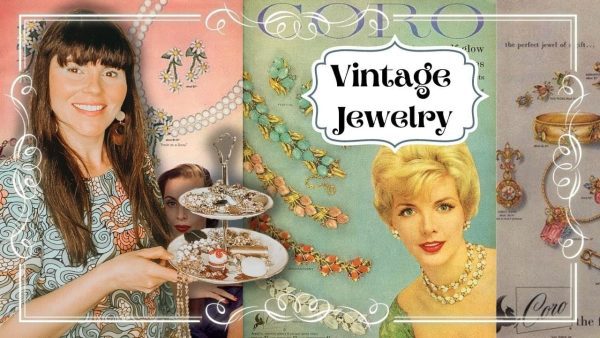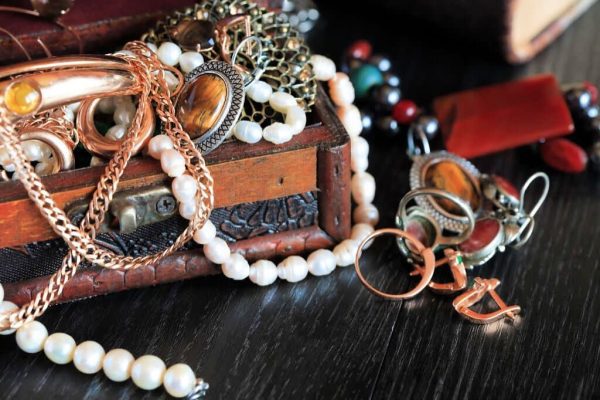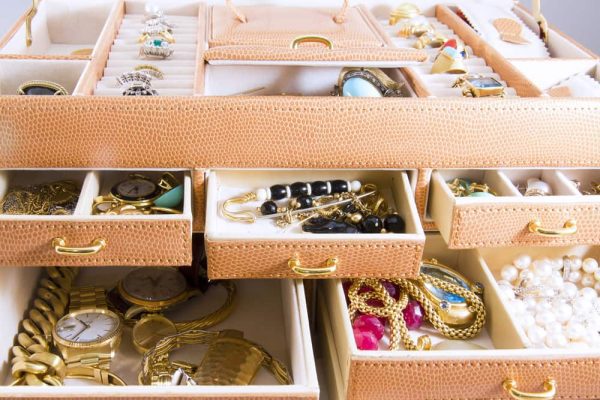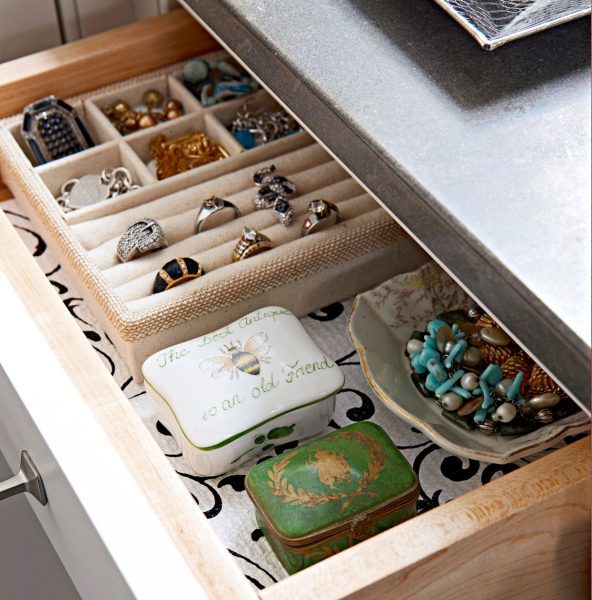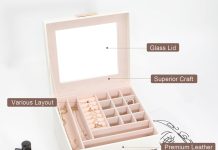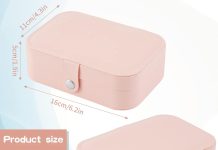I’ve always had a passion for vintage jewelry, and over the years, my collection has grown to the point where it feels overwhelming to keep everything organized. From delicate necklaces to intricate brooches, each piece holds a story and sentimental value. So, I wondered, how do I organize my vintage jewelry collection? After some trial and error, I’ve discovered a few tried-and-true methods that not only keep my treasures safe but also allow me to easily find and enjoy them whenever I please.
This image is property of i.ytimg.com.
Review contents
1. Sorting Your Jewelry
1.1 Sort by Type
When it comes to organizing your vintage jewelry collection, one of the first steps is to sort your pieces by type. Consider grouping your necklaces, bracelets, earrings, and rings together. This will make it easier to locate specific pieces when you’re getting ready for a special occasion or simply want to accessorize your outfit.
1.2 Sort by Material
Another helpful sorting method is to organize your vintage jewelry by material. Separate your pieces into categories such as gold, silver, gemstone, and costume jewelry. By doing so, you’ll be able to quickly find the perfect accessory to match your outfit or mood.
1.3 Sort by Era
If you have a diverse collection of vintage jewelry from different time periods, sorting by era can be a fascinating way to organize your pieces. Consider grouping them by decades, such as Victorian, Art Deco, or Retro. This not only makes for a visually appealing display but also allows you to easily appreciate the unique characteristics of each era.
1.4 Sort by Color
For those with a wide range of colorful vintage jewelry, sorting by color can be a fun and practical method. Arrange your pieces by shades or hues, such as grouping all your red or blue jewelry together. This sorting method can help you create aesthetically pleasing displays and also make it easier to find the perfect accessory to match your outfit.
1.5 Sort by Condition
Another important aspect of organizing your vintage jewelry collection is sorting by condition. Separate your pieces into categories like excellent, good, and needs repair. This will make it easier for you to prioritize any necessary maintenance or repairs and ensure that your beloved vintage pieces remain in top-notch condition.
2. Choosing Storage Solutions
2.1 Jewelry Boxes
A classic and popular storage solution for organizing your vintage jewelry collection is a jewelry box. These boxes come in various sizes and designs, providing compartments and drawers to keep your pieces safe and easily accessible. Look for options with soft lining or individual compartments to prevent items from tangling or scratching.
2.2 Drawer Dividers
If you prefer to store your vintage jewelry in a drawer, using dividers can be a great way to keep everything organized and easily visible. Drawer dividers can be adjusted to fit different sizes of jewelry and will help prevent tangling or damage. Consider using dividers made of materials like velvet or acrylic for an added touch of elegance.
2.3 Hanging Organizers
For those who have limited drawer or shelf space, hanging organizers can be a space-saving and functional solution for your vintage jewelry collection. These organizers typically feature multiple pockets or compartments, allowing you to hang them in your closet or on a wall. Hanging organizers are especially useful for storing necklaces and longer pieces.
2.4 Display Stands
If you have a selection of vintage jewelry pieces that you enjoy showcasing, display stands can be an ideal storage solution. These stands come in different designs and materials, such as acrylic or metal, and allow you to exhibit your favorite pieces while keeping them easily accessible. Display stands are especially suitable for rings, bracelets, and brooches.
2.5 Jewelry Trays
Jewelry trays are shallow, flat organizers with various compartments and sections, perfect for keeping your vintage jewelry collection neatly arranged. These trays can be stacked, allowing you to maximize your storage space while still keeping your pieces easily visible and accessible. Look for options with cushioned slots to protect delicate items from damage.
3. Labeling and Categorizing
3.1 Label Each Container
To further enhance the organization of your vintage jewelry collection, consider labeling each storage container. Whether it’s a jewelry box, drawer divider, or hanging organizer, adding labels will make it easier to quickly locate specific pieces. You can use adhesive labels, markers, or even decorative tags to add a personal touch to your organization system.
3.2 Create Categories
In addition to sorting your jewelry by type, material, era, color, and condition, creating specific categories can provide even more clarity and organization. For example, you might have categories such as “Everyday Favorites,” “Statement Pieces,” or “Special Occasion Jewelry.” By defining categories based on your preferences or intended use, you can easily find the perfect piece for any occasion.
3.3 Use Clear Containers
When it comes to storage containers for your vintage jewelry, opt for clear options whenever possible. Clear containers allow you to easily see the contents without the need to open each one. This saves you time and prevents unnecessary handling of delicate pieces. Transparent bags, boxes, or organizers are particularly useful for storing items like earrings or smaller accessories.
3.4 Organize by Accessory Type
Within each storage container, organize your vintage jewelry by accessory type. For example, within a jewelry box, separate your necklaces, bracelets, earrings, and rings into their respective compartments or sections. By organizing in this manner, you’ll be able to quickly locate and access the specific accessory you’re looking for.
4. Cleaning and Maintenance
4.1 Gentle Cleaning
Regular cleaning is essential to maintaining the beauty and longevity of your vintage jewelry. However, it’s important to handle these pieces with care. Use gentle cleaning methods, such as mild soap and warm water, to clean your jewelry. Avoid abrasive materials or harsh chemicals that could damage delicate gemstones or metals.
4.2 Polishing and Buffing
To restore the shine and luster of your vintage jewelry, consider using a jewelry polishing cloth or a soft microfiber cloth. Gently buff the surface of your pieces to remove any tarnish or dullness. This simple maintenance routine will help keep your vintage jewelry looking its best for years to come.
4.3 Storing in Anti-Tarnish Bags
To prevent tarnishing, especially for silver jewelry, consider storing your vintage pieces in anti-tarnish bags or pouches. These specially designed bags are made with materials that help absorb moisture and prevent oxidation, keeping your jewelry looking pristine. Remember to clean and dry your jewelry thoroughly before placing it in the anti-tarnish bags.
4.4 Regular Inspections
Make it a habit to regularly inspect your vintage jewelry for any signs of damage or wear. Look for loose stones, worn prongs, or any other issues that may require repairs. Catching these problems early on can prevent further damage and potentially save your beloved vintage pieces.
4.5 Professional Cleaning
For valuable or delicate vintage jewelry, it’s advisable to seek professional cleaning services from a reputable jeweler. They have the expertise and proper tools to handle and clean your pieces safely. Professional cleaning can deep-clean your jewelry, ensuring that dirt, grime, and any hidden debris are thoroughly removed.
This image is property of images.squarespace-cdn.com.
5. Creating a Display
5.1 Jewelry Frames
If you’re looking to showcase your vintage jewelry as both storage and decor, consider using jewelry frames. These frames often feature hooks or wires that allow you to hang your necklaces, bracelets, and earrings, turning them into functional works of art. Jewelry frames can be mounted on walls, providing a unique display and keeping your pieces easily accessible.
5.2 Shadow Boxes
Shadow boxes are another wonderful option for displaying and preserving your vintage jewelry collection. These shallow, glass-fronted boxes come in various sizes and can be mounted on walls or placed on tabletops. Arrange your favorite pieces within the boxes, creating visually stunning compositions that showcase the beauty of your vintage jewelry.
5.3 Jewelry Trees
For a whimsical and eye-catching display, consider using jewelry trees. These decorative stands often have multiple branches or arms where you can hang your necklaces, bracelets, and even rings. Jewelry trees not only keep your pieces organized but also add a touch of elegance to your space. Look for options in different materials and designs to suit your personal style.
5.4 Curio Cabinets
If you have a larger collection of vintage jewelry, a curio cabinet can be an excellent display solution. These glass-fronted cabinets often have built-in shelves and compartments, allowing you to showcase your pieces while keeping them safely protected. Curio cabinets also provide the opportunity to arrange your vintage jewelry collection by color, material, or era for an aesthetically pleasing display.
5.5 Wall-Mounted Hooks
For a simple and budget-friendly display option, consider installing wall-mounted hooks. These hooks can be installed directly on your walls or on a decorative board, allowing you to hang your necklaces and bracelets while creating a visually appealing arrangement. Wall-mounted hooks keep your vintage jewelry organized, easily accessible, and are particularly suitable for pieces with unique or intricate designs.
6. Handling Special Pieces
6.1 Vintage Watches
Vintage watches require special care, both in storage and maintenance. If possible, keep your vintage watches in their original boxes or cases to protect them from dust, moisture, and potential damage. Regularly wind and run the watches to prevent them from fully stopping or getting out of sync. Consider consulting a professional watchmaker for any necessary repairs or maintenance.
6.2 Fine Gemstones
If your vintage jewelry collection includes pieces with delicate gemstones, it’s crucial to handle them with care. Avoid exposing gemstone jewelry to harsh chemicals, extreme temperatures, or direct sunlight, as they can damage or fade the stones over time. Regularly check your gemstone jewelry for loose stones or any signs of damage and have them repaired by a reputable jeweler.
6.3 Delicate or Fragile Items
Some vintage jewelry pieces may be particularly delicate or fragile, requiring extra caution during handling and storage. It’s advisable to store these pieces individually in soft, padded pouches or boxes to prevent scratching or tangling. When wearing delicate vintage pieces, be mindful of activities or clothing that could potentially damage or snag them.
6.4 Statement Necklaces
Statement necklaces are often bold, elaborate pieces that can take center stage in any outfit. To prevent tangling, store these necklaces flat in separate compartments or hang them individually on hooks or jewelry displays. When wearing a statement necklace, be mindful of its weight and avoid tugging or placing excessive strain on the chain or clasps.
6.5 Signature Pieces
If you have signature pieces in your vintage jewelry collection that hold special value or sentimental significance, it’s important to treat them with extra care. Store these pieces in separate containers or compartments to avoid scratches or damage. Consider having them appraised and insured to protect their value, both monetary and sentimental.
This image is property of sammydvintage.com.
7. Documentation and Cataloging
7.1 Photographing Your Collection
Documenting your vintage jewelry collection through photographs can be a valuable tool for organization and insurance purposes. Take clear, detailed photos of each piece, preferably against a white or neutral background. Capture close-up shots of any unique or intricate details. This documentation will not only serve as a cataloging reference but also help you remember and appreciate your collection.
7.2 Creating an Inventory Spreadsheet
To keep track of your vintage jewelry collection, consider creating an inventory spreadsheet. Include columns for item descriptions, types, materials, eras, and any additional notes or details you find relevant. This spreadsheet will allow you to easily search and sort your collection, making it convenient to locate specific pieces or to provide detailed information if needed.
7.3 Valuing Your Jewelry
Having an understanding of the value of your vintage jewelry collection is essential, especially for insurance purposes or when considering selling or appraising your pieces. Research similar items online, consult with reputable jewelers or appraisers, and keep track of any original receipts, certificates, or documentation that may provide insights into the value of your jewelry.
7.4 Keeping Receipts and Certificates
For valuable or unique vintage jewelry pieces, it’s important to keep original receipts, certificates, or appraisal documents. These records provide provenance and authenticity, making them crucial if you ever decide to sell or have your pieces appraised. Store these documents safely, preferably in a fireproof safe or a secure digital storage solution.
7.5 Appraisals and Insurance
Consider having your vintage jewelry collection professionally appraised by a reputable jewelry appraiser. An appraisal not only provides a documented evaluation of your pieces’ value but also helps with insurance coverage. Insuring your vintage jewelry collection ensures that you are financially protected in the event of loss, theft, or damage. Consult with your insurance provider to determine the best coverage for your collection.
8. Rotation and Refreshing
8.1 Seasonal Rotation
To keep your vintage jewelry collection fresh and exciting, consider implementing seasonal rotation. In the same way you rotate your wardrobe, periodically switch out your jewelry pieces to match the season or occasion. This not only allows you to showcase different pieces but also prevents overexposure and potential damage from constant wear.
8.2 Mixing and Matching
Vintage jewelry is incredibly versatile, and one way to refresh your collection is by mixing and matching different pieces. Experiment with layering necklaces, stacking rings, or combining different styles and eras. Play with colors, textures, and materials to create unique and personalized looks that reflect your individual style.
8.3 Incorporating Modern Pieces
While vintage jewelry holds timeless appeal, incorporating modern pieces into your collection can add a fresh and contemporary touch. Mix modern designs with vintage classics to create a unique and eclectic ensemble. Experiment with contrasting styles to create a look that is uniquely yours.
8.4 Customizing Vintage Jewelry
Personalize your vintage jewelry collection by customizing or reimagining certain pieces. Consider working with a reputable jeweler to modify or enhance vintage items to better suit your taste or style. Transform a vintage brooch into a pendant or repurpose vintage earrings into a unique and memorable charm bracelet.
8.5 Reimagining Outdated Pieces
If you have vintage jewelry pieces that have fallen out of favor or are no longer your style, consider reimagining them into new, wearable pieces. Collaborate with a skilled jeweler to repurpose vintage elements into trendy and fashionable designs. This allows you to breathe new life into neglected pieces and create a collection that reflects your evolving style.
This image is property of 3.bp.blogspot.com.
9. Traveling with Your Collection
9.1 Using Jewelry Rolls
When traveling with your vintage jewelry collection, using a jewelry roll can keep your pieces organized and protected. Jewelry rolls typically have multiple compartments or pouches to keep your accessories separate and prevent tangling. Look for rolls with padded sections for added protection, and choose one that can be easily secured with clasps or ties.
9.2 Compact Travel Cases
For those who prefer a more secure and structured solution, compact travel cases designed specifically for jewelry are an excellent option. These cases often feature individual compartments and secure closures, offering optimal protection and organization for your valuable vintage pieces. Look for cases with designated areas for different types of jewelry to prevent damage during travel.
9.3 Packing Strategically
When packing your vintage jewelry for travel, it’s important to pack strategically to minimize the risk of damage or loss. Remove any delicate or sentimental pieces that you can’t bear to lose and store them separately. Utilize small, protective pouches or zip-top bags for each accessory to prevent tangling or scratching. Place your jewelry pouches or cases in a secure and easily accessible area of your luggage.
9.4 Insurance and Security
Before traveling with your vintage jewelry collection, review your insurance coverage to ensure it extends to your valuables while on the move. If necessary, consider purchasing additional travel insurance or adding a rider to your existing policy. Take precautions to secure your jewelry at all times, such as using hotel safes or keeping it on your person during transit.
9.5 Keeping a Detailed Checklist
To avoid leaving any pieces behind or misplacing them while traveling, create a detailed checklist of your vintage jewelry collection. Include descriptions, photographs, and any identifying details to make it easier to locate and identify your pieces. Use this checklist before and after your trip to ensure that everything is accounted for and in its rightful place.
10. Preserving the Legacy
10.1 Passing Down Heirlooms
If you have vintage jewelry pieces that hold sentimental value and are intended to be passed down through generations, it’s important to plan for their preservation. Consider documenting the history and stories associated with these pieces, ensuring that future generations understand their significance. Arrange for these heirlooms to be properly stored and protected, and communicate your wishes for their future ownership.
10.2 Documenting Family Stories
Vintage jewelry often carries stories and memories of generations past. Take the time to document the stories associated with your vintage jewelry collection. Interview family members or consider writing down your own personal anecdotes. This documentation adds depth and meaning to the jewelry, creating a lasting legacy for future generations.
10.3 Seeking Professional Help
If you have valuable or historically significant vintage jewelry pieces, it may be worth consulting with professionals who specialize in vintage jewelry preservation. Conservationists, historians, or specialized jewelers can provide guidance on proper storage, maintenance, and restoration techniques. Their expertise ensures that your vintage jewelry pieces remain in excellent condition and retain their maximum value.
10.4 Creating a Display for Family
Consider creating a dedicated space or display for your vintage jewelry collection that can be enjoyed by your family and loved ones. Whether it’s a small corner in your home or a larger showcase, this display provides an opportunity for your family to appreciate and connect with the history and beauty of your vintage jewelry pieces.
10.5 Sharing the Beauty
Share your love for vintage jewelry by using pieces from your collection to accessorize special occasions or family events. Allow family members to wear and enjoy the jewelry, passing on the joy and appreciation for vintage pieces. It’s a beautiful way to create cherished memories and ensure that the legacy of your vintage jewelry lives on for generations to come.
This image is property of www.bhg.com.



